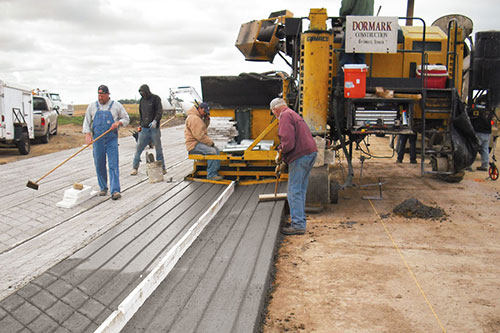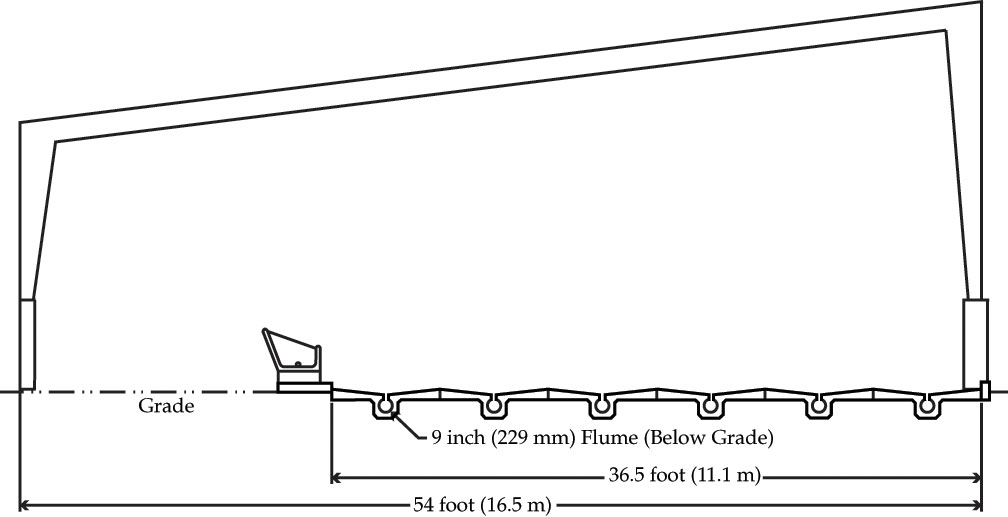GOMACO World Index --- GOMACO World 40.1 - June 2012
A Unique Slipforming Application in an Iowa Cattle Yard
Slot drain is typically a European slipform application and not very common in the United States. It's even more uncommon in the cattle yards of the Midwest. It has been done, though, and just recently in Akron, Iowa, where Dormark Construction Company slipformed a flush flume floor with their GOMACO three-track Commander III for a cattle confinement. The flume featured a nine inch (229 mm) diameter slot drain set inside a six foot (1.8 m) wide floor profile. Six individual flumes slipformed side by side formed the 36.5 foot (11.1 m) wide final floor profile for the cattle shed. The flume, with the slot drain in the top, allows the cattle manure to collect in the drain where it is flushed into a lagoon.
Dormark was originally planning to slipform the profile over an inflatable tube to create the round drain. After a visit to GOMACO headquarters in Ida Grove, Iowa, that plan changed. Russ Vetter, Project Manager for Dormark, had the opportunity to meet with Wayne Saywell, a service technician from GOMACO International Ltd. in Witney, England. They discussed the project and Saywell convinced Vetter to reconsider his plan and use a mold that pulled a torpedo-style blockout to form the opening on-the-go while the profile was being slipformed, eliminating the inflatable tube.
"Another contractor originally did this type of floor in 1974 using a GOMACO and an inflatable tube," Vetter explained. "Wayne convinced me to use the torpedo-style slipforming and I can't thank him enough. I was absolutely astounded by how fast and how well this project slipformed."
Dormark modified an existing sidewalk mold to create the unique profile. Concrete for the project was brought to site by a local supplier using ready-mix trucks. The mix design was a state of Iowa 4000 psi (27.6 MPa) modified C4 concrete with red granite rock and fiber mesh. Slump averaged 1.5 inches (38 mm).
"We would pour one 1000 foot (305 m) run in six to seven hours with the Commander III," Vetter said. "As soon as we were done pouring, we'd start up our GOMACO GT-6000 and trim the next run. The next day, an excavator would dig out the trench for the flume. Then, we'd be back in again slipforming another 1000 foot (305 m) long run, so on average we were making a pour every other day."
Behind the mold, cure-sprayed pieces of Styrofoam were inserted into the opening of the slot drain to help keep the opening from filling in. The Styrofoam was later removed and reused on the next paving run. Chamfered steel blades were welded to the back of the mold to create longitudinal grooves in the floor's profile, and workers behind the Commander III used hand floats to add a crossing groove into the new profile. The grooves improve traction for the cattle as they walk across the floor.
"Since we completed the project, I've been showing the pictures to everyone and the first thing they ask me is, 'How did you do that?'" Vetter said. "It worked great and I consider the project a great succes. I'd like to thank everyone at GOMACO because this project wouldn't have been possible without their help."
So far, Dormark's flush flume floor is a one-of-a-kind project for the company, but they wouldn't rule out slipforming another. They have the equipment, knowledge, and now the experience to slipform it again.
Subscribe to Receive GOMACO World Magazine


